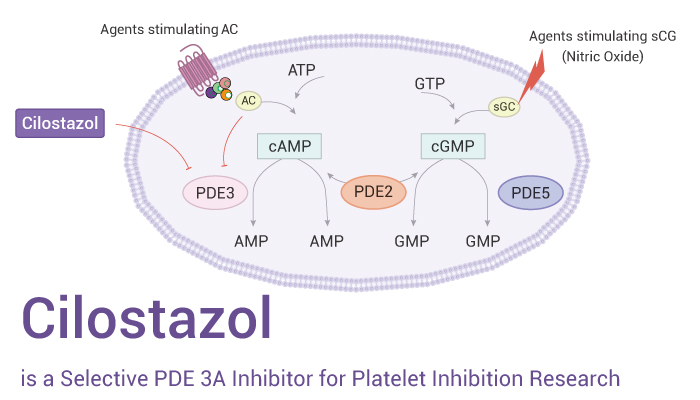PDE3 is a phosphodiesterase primarily expressed in platelets, vascular smooth muscle cells, cardiomyocytes, and hepatocytes. It regulates cardiac muscle, vascular smooth muscle, and platelet aggregation. In particular, it modulates cardiac and vascular smooth muscle contraction, and inhibition of PDE3 may inhibit heart failure. Both PDE3A and PDE3B are expressed in vascular smooth muscle cells, and their expression in vascular smooth muscle changes under specific conditions (such as elevated cAMP and hypoxia).

Cilostazol (OPC 13013) is a potent and selective inhibitor of PDE 3A in the cardiovascular system.
It (OPC 13013) inhibits PDE 3A in platelets with an IC50 of 0.2 μM, and it prevents platelet aggregation and exerts an antithrombotic effect. Cilostazol dose-dependently inhibits stress-induced and ADP-induced human platelet aggregation (SIPA) with IC50s of 15 μM and 12.5 μM, respectively. It also directly and effectively inhibits the activation of HSCs but not Kupffer cells. Increased intracellular cAMP levels and protein kinase A (PKA) activation reduce PDGF-stimulated cell proliferation. It is also effective against the development of non-alcoholic fatty liver disease by activating the cAMP/PKA signaling pathway in the body. Also, there may be a link between PDGFR downregulation and cAMP/PKA signaling in HSCs.
In in vivo studies, Cilostazol (0.1%-0.3% w/w; p.o. via pellet food; 2 weeks) exerted neuroprotective effects against acute brain injury following cerebral ischemia in rats. Cilostazol (clinical doses; taken orally for 2 weeks) attenuates CCl4-induced liver fibrosis in vivo, possibly due to its direct inhibition of HSC activation. Cilostazol (i.p.; 10 mg/kg; 7 consecutive days after ischemia) attenuates neurological deficits, brain atrophy, and infarct size, and inhibits astrocyte proliferation/glial scarring 7 days after ischemia days and 28 accelerated angiogenesis in the ischemic border zone.
In summary, Cilostazol is a potent inhibitor of PDE3A, preventing platelet aggregation and activating the cAMP/PKA signaling pathway. It has antithrombotic and post-ischemic neuroprotective effects.
References:
[1]. Schrr K. Diabetes Obes Metab. 2002 Mar;4 Suppl 2:S14-9.
[2]. Minami N, et al. Life Sci. 1997;61(25):PL 383-9.
[3]. Saito S, et al. Hepatol Res. 2013 Apr 19.
[4]. Ye YL,et al. Eur J Pharmacol. 2007 Feb 14;557(1):23-31. Epub 2006 Nov 10.